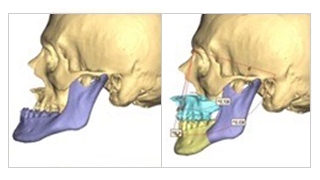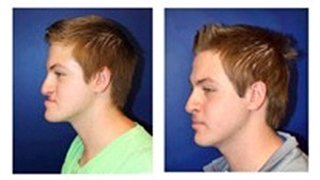Surgical Care for Teens with Cleft Lip and Palate
Published on
In Utero InsightsPublished on
In Utero Insights Images showing computer-generated model surgery done in preparation for double jaw surgery.
Because the face and oral structures change as a child grows, the interdisciplinary team in our Cleft Lip and Palate Program follows children from before birth through adolescence. We aim to have most of the surgical procedures required to correct the cleft difference completed by the time a child reaches skeletal maturity. However, two key procedures patients often require at skeletal maturity in the teen years are jaw surgery and corrective nasal surgery (rhinoplasty).
Images showing computer-generated model surgery done in preparation for double jaw surgery.
Because the face and oral structures change as a child grows, the interdisciplinary team in our Cleft Lip and Palate Program follows children from before birth through adolescence. We aim to have most of the surgical procedures required to correct the cleft difference completed by the time a child reaches skeletal maturity. However, two key procedures patients often require at skeletal maturity in the teen years are jaw surgery and corrective nasal surgery (rhinoplasty).
Cleft lip and palate patients can have underdevelopment of the upper jaw, resulting in maxillary retrusion and a flattened facial profile. In these cases, upper jaw growth lags behind lower jaw growth. This can cause appearance differences (an underbite) as well as pain with chewing that can increase the child’s risk for temporomandibular joint (TMJ) dysfunction.
 Patient shown before and after double jaw surgery with Dr. Taylor.
The technology used to perform jaw surgery has radically changed for the better over the past five years, and our team at CHOP has been on the forefront of some of those changes. For example, we can now create computergenerated patient-specific plates and screws that allow us to perform surgery faster and more accurately. This accuracy translates to a quicker recovery from surgery and less orthodontic care needed after surgery.
Patient shown before and after double jaw surgery with Dr. Taylor.
The technology used to perform jaw surgery has radically changed for the better over the past five years, and our team at CHOP has been on the forefront of some of those changes. For example, we can now create computergenerated patient-specific plates and screws that allow us to perform surgery faster and more accurately. This accuracy translates to a quicker recovery from surgery and less orthodontic care needed after surgery.
Cleft lip and palate can have a tremendous effect on the form and function of the nose, and definitive septorhinoplasty is often the final intervention for many cleft patients. Our goals are symmetry and harmony at all levels of the nose, relief of any nasal obstruction, and long-term stability. Definitive cleft rhinoplasty usually entails common rhinoplasty maneuvers — nasal bone osteotomies, septoplasty, dorsal reduction/augmentation, spreader grafts to the middle vault to improve breathing, lower lateral cartilage refinement and repositioning — but often these must be done in a more radical fashion than typical for aesthetic rhinoplasty. The importance of this final surgery is not to be underestimated and its value is often seen in the confident smile that accompanies the final result.
Reference
Current concepts in orthognathic surgery. Naran S, Steinbacher DM, Taylor JA. Plast Reconstr Surg. 2018;141(6):925e-936e.
Contributed by: Jesse A. Taylor, MD
Categories: Cleft Lip and Palate